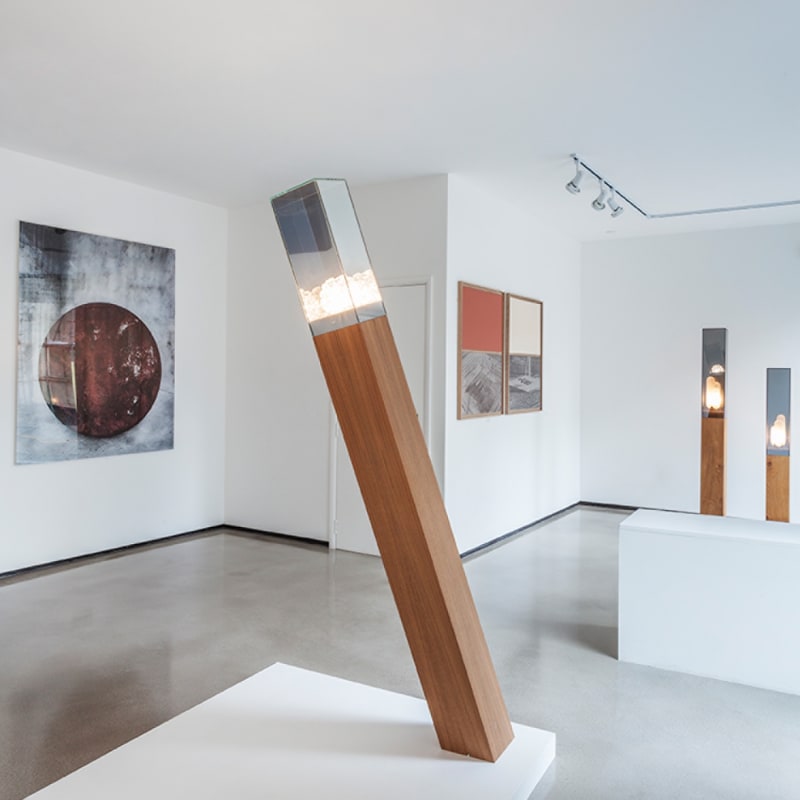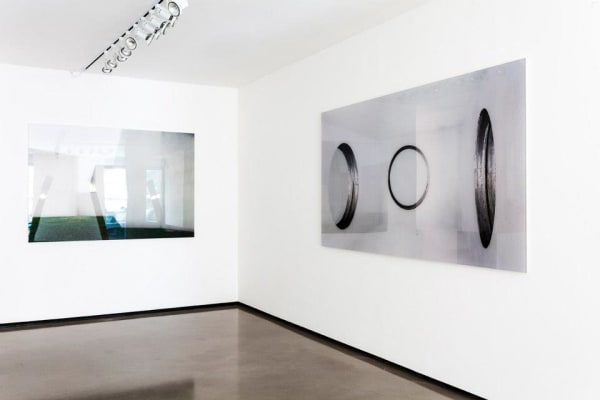ØYSTEIN DAHLSTRØM & AMIR FATTAL: DAHLSTRØM & FATTAL
It constructs for a time what is both a counter-city and the perfect society; it imposes and ideal functioning, but one that is reduced like the evil that it combats, to a simple dualism of life and death.
– Michel Foucault, on the Panopticon, from Discipline and Punish, 1975
We live in this world which for us has the disquieting strangeness of the desert and the simulacrum, with the veracity of living phantoms … because the desert of cities is equal to the desert of sand, where only the vertiginous seduction of a dying system remains, where only the wind watches over the sand.
– Jean Baudrillard, from Simulacra and Simulation, 1985
In Discipline and Punish, theorist Michel Foucault probes questions at the short-lived Panopticon[1]: who was truly imprisoned? Who was being watched? And who was responsible for looking? Here, the roles of power are subverted, and Foucault uses this as a metaphorical model for his heterophobia: the space of otherness trapped between the physical and imagined, outside of infrastructure and time, like a reflection in a mirror, or places imagined, historical or recollected.
A process of pulling the wool over one’s eyes: to hoodwink – a mastery where meaning is translated through the hands of the artist as magician – in one instance, an artist creates only an impression of what was once autonomous fact, and in the next moment, meaning becomes generated from nothingness. In both cases, absence of materiality does not correlate to an absence of meaning, for there is power in the act of seeing, and these modes are abundant in their knowledge, sublime in their sense of (real or implied) space, uncanny in their ability to seduce the viewer from reticence into a state of recollection.
The work of Berlin-based Amir Fattal includes appropriated imagery screen printed onto metal, light-fixtures trapped between transparencies, reflective surfaces that have been doubled back upon the viewer, and most recognizably, his trademark ‘light-fixtures’. For the latter, Fattal began arduously collecting items from post-mortem furniture collection agencies; various lamps he collected spoke to him most – eventually providing the focal point of an ongoing series of stark sculptural pieces with lamps perched atop modernist, modular, plinth-like formations.
Fattal’s overarching concerns might be the lines of communication and culture that have been drawn between two very different countries (Germany and Israel) as linked through history, memory, architecture, and the geographical diaspora[2]. His sources of reference are varied, including the 2nd World War, 20th century architecture, and biographical narratives of prominent political and architectural figures in German and Israeli history. The work’s locus is how subjectivity reshapes the ‘Political’, particularly when we (as a society) consider war as a porous historical entity, or even as a narrative. If history loses its veracity with time, Fattal positions his practice within this enveloping concept, disclosing the unreliability within historical retellings. One begins to see how Fattal’s work traces a particular history, whereby the artist interweaves narrative and fact into his own artistic and political sensibilities, where the meta-narrative collapses and meaning resurfaces as blurred fragments. It is a work concerned with an ethics of persons and politics, stylistically recalling artists like Robert Morris and Larry Bell of the particularly macho Modernist movement of the 1960s, while articulate of relevant social and cultural issues for the Israeli-born Fattal. It is a practice of taking the concrete and making it conceptual – history as though viewed through a lens of inaccuracy, a mastery of dimmed lights and half-truths, where infrastructure and truth are replaced by verisimilitude, a ‘smoke and mirrors’ retelling of an already phantom history.
In a related but also sharply contradictory style to Fattal, Øystein Dahlstrøm creates meaning from anti-meaning: it is of paramount importance that his works be understood – not as photography – but as simulacra: digital renderings of the natural world that masquerade as truth, with the attempt to trick and convince the viewer into accepting their recreated fantasy as absolute truth. Where Fattal blurs and omits, Dahlstrøm articulates and discloses, and his visual trickery is defined (and redefined) to infinitesimal detail. Yet, with keen reflexive awareness of this (lack of) accuracy, Dahlstrøm further subverts his technical process by selecting subject matter that is categorically displaced in any traditional sense: Shattered features layered, broken panes of glass revealing a blackened void; a non-descript white wall in Castle withholds as much – if not more – than it choses to expose, its title suggesting a narrative beyond the subdued concrete planes, where a shock of green grass provides a welcome relief from an otherwise stark composition. These two images are characteristic of Dahlstrøm’s practice: where there remains an element of purposeful and marked disquiet upon viewing his work, not unlike a feeling of lingering guilt, or the awareness that something is just not quite right. For Dahlstrøm, the Foucault–worthy anti-space prevails – isolating and elevating the heterotopian: forgotten corners, overlooked ruins, endless horizons of cement, broken windows, open doors and a series of darkened spaces.
Both artists are interested in a sort of optical mastery – for Fattal, it is the darkening of historical accuracy, whereas Dahlstrøm shines a light in an attempt to reveal the underexposed. As viewers, we place ourselves in the role of the protagonist – our situation questioned by the sublimity of questions presented by the spaces in which we operate. One can imagine how the annals of history creates a narrative that – over time – threatens to diminish historical individuality in place of a muddled concept of time, space, and existence, where the limits between the imagined and the physical world cease to exist.
[1] An 18th century, English prison-model in which the warden sits in the ‘cornea’ of a circular infrastructure, and is surrounded on 360 degrees by prisoners.
[2] That being the initial immigration and subsequent emigration of Jews from Germany after World War II.
ØYSTEIN DAHLSTRØM
Øystein Dahlstrøm’s (b. 1976, Norway) work focuses on that which is not always pleasant but prefers to render incomplete emotions and distorted states-of-being through the computer-generated image. For Dahlstrøm, this pursuit is not meant to appease: there remains an element of dissatisfaction upon viewing, like the lurking feeling of guilt when something has been forgotten. His subjects are typically these anti-spaces: corners, ruins, cement-planes, broken windows, open doors and bleak entrances. The absence of material does not necessarily mean an absence of meaning, or beauty; for these landscapes are beautiful in the sublime or uncanny sense. Dahlstrøm is based in Norway, and he holds a MA from the Bergen Academy of Fine Art (2006).
AMIR FATTAL
Amir Fattal attended the Meisterschueler Bildende Kunst, UdK Berlin, as well as Absolventen Bildende kunst, UdK Berlin. He also attended The School of the Art Institute in Chicago, Illinois, as part of the Scholarship Exchange Program from UdK. In 2010 Fattal was awarded the Berlinersenat Arbeitsstipendium Bildende kunst, and in 2008 the GASAG Foeredepreis. In 2011, Fattal had solo exhibitions with Artitude Kunstverein Berlin titled Shadow of Smoke Rings on the Wall, as well as The Last Picture, at Teapot Gallery, Cologne. In 2010, he had a solo exhibition with Wilde Gallery titled Tomorrow gets me Higher, and in 2009 Master exhibition at UdK in Berlin. In 2008, his solo exhibition was titled Sunset Rising at Teapot Gallery, Cologne, and in 2007 he had a solo exhibition with AA Gallery in London Private Dancer.
Group exhibitions in the last two-years include Body without Body – Georg Kolbe Muesum Berlin (2011), Berliner Zimmer Genossen Funkhaus Berlin (2011), The beauty in seduction MK Gallery Berlin (2011), I’m the Antenna MINKEN & PALME, Berlin (2011), Metrospective 1.0 Program Gallery Berlin (2011), Selected artists NGBK Berlin (2011), Saccharine curated by Ana Finel Honigman, Grimmuseum, Berlin (2010), Statics and the movement in between, MK Galerie Berlin (2010), Are you coming too? September Gallery Berlin (2010), Three Man Show Fabrice Gygi, Brock Enright and Amir Fattal, COMA Gallery, Berlin (2010), Source / Resource Group exhibition at Wilde Gallery Berlin (2010), In fifteen minutes everybody will be famous, Group exhibition curated by Anna Erickson, Tape Modern, Berlin (2010).
Amir Fattal was born in Tel Aviv, Israel and currently lives and works in Berlin, Germany.


















